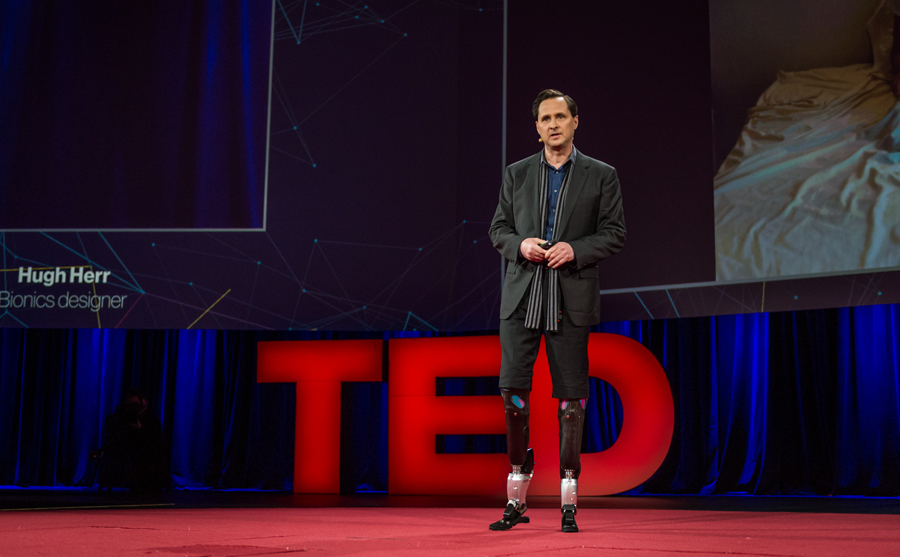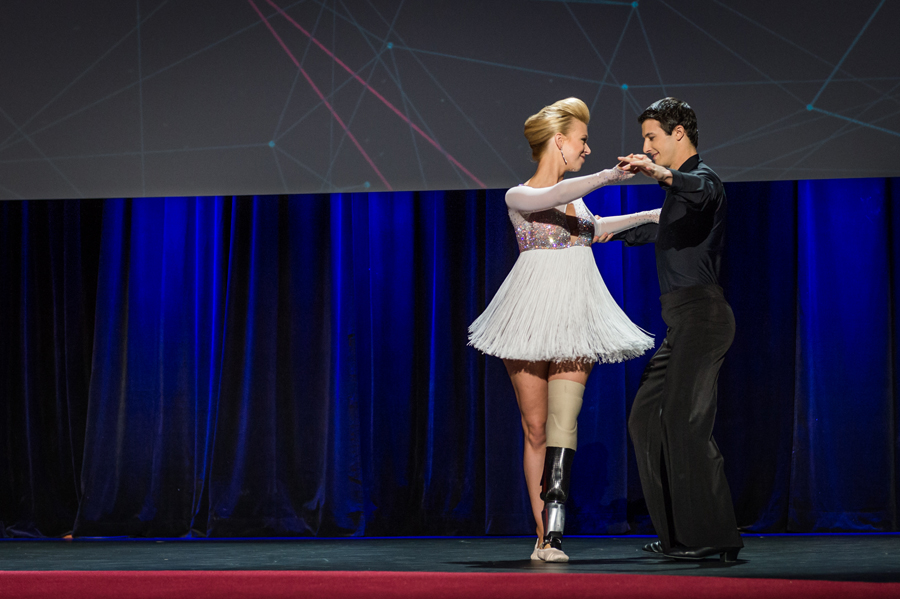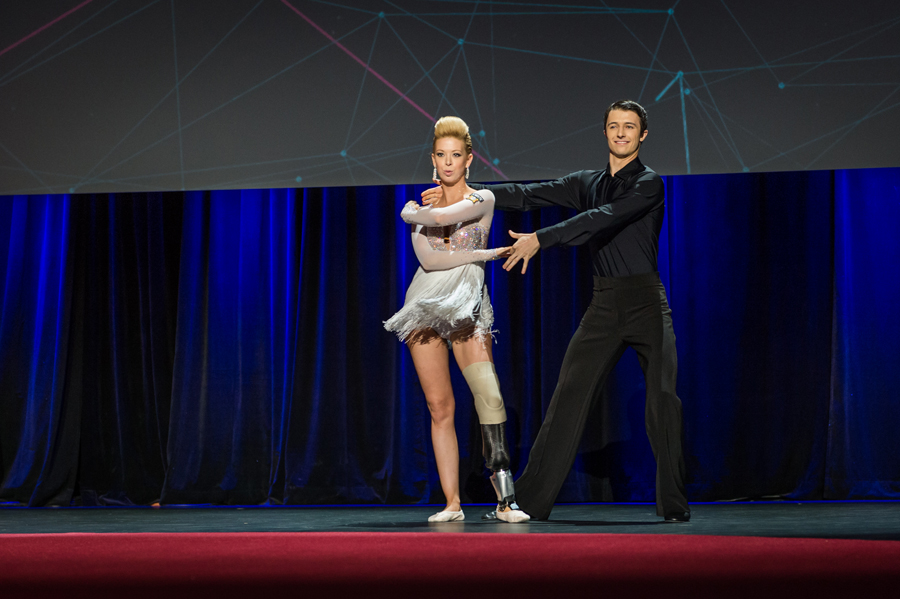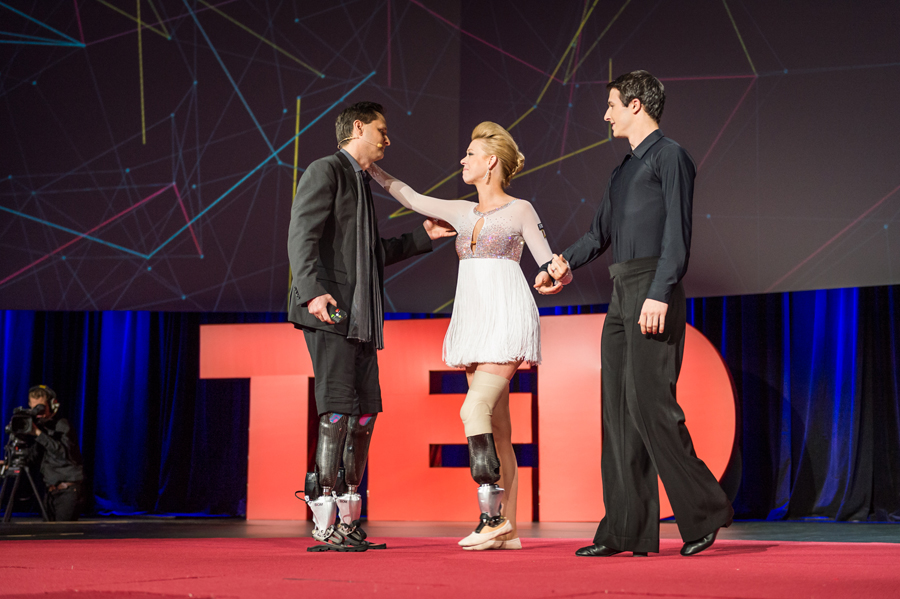
Hugh Herr talks about the new prosthetics his team is creating at the MIT Media Lab. This is a highly personal talk, as Herr both creates and uses these limbs. Photo: James Duncan Davidson
Hugh Herr, director of the Biomechatronics Group at The MIT Media Lab, strolls onto the TED2014 stage in a pair of long, black shorts. Normally, what he’s wearing wouldn’t be of note—except that he’s chosen his ensemble today to show us something. Below the hem of his shorts, we see that he has two prosthetic legs. His lab not only creates bionic limbs; he wears them himself.
“Bionics explores the interplay between biology and design,” says Herr. “Today, I will tell human stories of bionic integration. Of how electromechanics attached to the body and implanted inside the body are beginning to bridge the gap between disability and ability, between human limitation and potential.”
Herr begins by telling his story—his legs were amputated after he got frostbite during a rock climbing accident in 1982. “At the time, I didn’t view my body as broken. I reasoned that a human being can never be broken,” he says. “I thought: Technology is broken. Technology is inadequate. This simple but powerful idea was a call to arms to advance technology to the elimination of my own disability, and ultimately the disabilities of others.”
Herr began in the field of prosthetics with the idea that the body is malleable, a blank slate that could be improved. He created special limbs to help him return to rock climbing—and to be better than he had been before. His thin prosthetic feet allowed him to wedge into spaces where a foot couldn’t fit and to don special spiked feet in order to climb vertical ice. He adjusted his height as he chose — and jokes,”When I was feeling badly about myself and insecure, I would jack myself up a few inches,” he says. “When feeling sauve, I’d knock down my height down just to give my competition a chance.”
Throughout his career, a simple idea guided Herr’s work. “I imagine a future so advanced that we could rid the world of disability—in which neuroimplants allowed the blind to see, in which the paralyzed could walk with exoskeletons,” he says. “We need to do a better job in bionics to allow full rehabilitation.”
At the Center for Extreme Bionics at the MIT Media Lab, Hugh and his team work on the science and technology to allow repair of humans across a broad range of brain and body issues. A focus is bionic limbs. For these limbs, there are three areas of improvement involved: the mechnical, the dynamic and the electric.
The mechanical has to do with how prosthetics are attached to the body. And this is a true challenge, says Herr. “One of the oldest technologies in the human timeline—the shoe—still gives us blisters. We have no idea how to attach things to our body,” he says. Prosthetics, he explains, are attached via synthetic skins. To create this, his lab uses an round rig of actuators that measure the shape of the remaining limb and the tissue compliance at each anatomical point. They use fMRI to figure out precise geometry. The rule is: where the body is stiff, the skin should be soft and vice versa. “We produce the most comfortable limbs I have ever worn,” says Herr.
Next, come the dynamic challenges. To make prosthetics that “move like flesh and bone,” Hugh’s team uses a smart material which is floppy like paper but becomes stiff like a board when voltage is applied. They attach this to the synthetic skin. “When I walk, there’s no voltage, and my interface is soft compliant,” he says. “But when voltage is applied, it stiffens, creating greater maneuverability of limb.”
The lab studies how people with disabilities walk and run, to understand exactly what happens in the body when these deceptively easy things are done. They use this information, on which muscles are doing what and how they’re being controlled by the brain, to create limbs that work like natural ones. On heel strike, the system modulates stiffness and then lifts the person into walking stride just like the muscles in the calf region. These bionics allow wearers to walk up stairs easily, even run up steep inclines.
The lab is also working on exoskeleton-like devices, which Herr predicts everyone will wear in the future to protect their limbs during activities like running. In a version made for people who aren’t missing limbs at all, the exoskeleton actually augments walking, applying torque and power as needed. “We’re beginning the age in which machines attached to our bodies will make us stronger and more efficient,” says Herr.
And finally, Herr explains the electric challenges, which determine how a prosthetic “connects with my nervous system.” For this, the lab measures electrical pulses of muscles and what happens when a person thinks about moving their limb. They embed this capability in the chips of bionic limbs. To demonstrate how this works, Herr begins to run. “That was the first demonstration of a running gait under neural command,” he says. “The more I fire my muscles, the more torque I get.”
But really, Herr says there is much more to be done from here. “We want to close the loop between the human and the bionic limb,” he says. “We’re doing experiments where we’re growing nerves … When this is fully developed, persons like myself will not only have synthetic limbs that move like flesh and bone, but that feel like flesh and bone.”
Herr hopes to work to make these next-generation prosthetics both available and affordable. “The basic levels of physiological function should be part of basic human rights,” says Herr. “It’s not well appreciated, but over half the world’s population suffers from some kind of cognitive, emotional, sensory or motor condition. Every person should have the right to live without disability, if they choose to.”
Herr brings it back to the personal, telling the story of Adrianne Haslet-Davis, a professional ballroom dancer whose left leg was partially amputated after the Boston Marathon bombing. Herr had the honor of meeting her at a rehabilitation hospital in Boston and, after hearing her story, decided, “Let’s build her a bionic limb.”
Herr’s lab launched a 200-day research period to study the dynamics of dance — to look at how dancers move and what forces they apply while they go. They embedded the fundamentals of dance into a limb for Haslet-Davis.
“In 3.5 seconds, the criminals and cowards took Adrianne off the dance floor,” he says. “In 200 days, we put her back.”
With that, Herr calls Haslet-Davis out for what will be her first dance since the bombing, just a little under a year ago.
Haslet-Davis steps on stage with her partner, professional dancer Christian Lightner. The two begin to dance a rumba, Haslet-Davis performing intricate back-and-forth footwork. To Enrique Iglesias’ “Ring My Bells,” she twirls around her partner as the white fringe of her skirt flaps in the air. Her body looks lithe and unimpaired. Her bionic foot is encased in a white dancing slipper, just like her right foot.
It’s a stunning moment. One that underscores Herr’s ultimate point.
“Bionics are not only about making people stronger and faster,” he says. “Our expression, our humanity can be embedded into our electromechanics.”

Adrianne Haslet-Davis begins her rumba. Photo: James Duncan Davidson

Haslet-Davis mid-dance. Photo: James Duncan Davidson

Adrianne Haslet-Davis thanks Hugh Herr on the TED stage. Photo: James Duncan Davidson
Comments (50)
Pingback: #TED2014 | Everly So
Pingback: Volvió a bailar después de perder la pierna en el atentado de Boston | La Tlayuda News
Pingback: Robotics | Telepresence robot. At TED, miracles and fears
Pingback: At TED, miracles and fears | Digital News Daily CA
Pingback: Hugh Herr on the TED2014 Stage - Play Foundation
Pingback: Volvió a bailar después de perder la pierna en el atentado de Boston | Notidiarias
Pingback: Volvió a bailar después de perder la pierna en el atentado de Boston | Fm Libertad 102.5
Pingback: Bionic Breakthroughs: Sensing, Feeling, Dancing Limbs! | Stories by Williams
Pingback: Boston Marathon bombing survivor dances with bionic leg at Ted Talks Vancouver - National | Globalnews.ca
Pingback: Adrianne, che danza senza gamba grazie a Hugh, che costruisce il futuro | Paralimpici
Pingback: Adrianne Haslet-Davis, Boston Bombing Amputee, Dances For 1st Time | British Columbia Tours
Pingback: Mpower | Abilities Discovered
Pingback: Dancing Again, This Time on a New Leg | Dance Spirit
Pingback: Boston Marathon bombing survivor dances onstage at TED Talk | Slam! sports blog
Pingback: In case you missed it: Day 3 at TED2014 | BizBox B2B Social Site
Pingback: Bionic nerves, we grow old but with no arthritis, huzzah!!! | Architectradure
Pingback: Boston Marathon bombing amputee dances again with help from MIT engineer | New York news